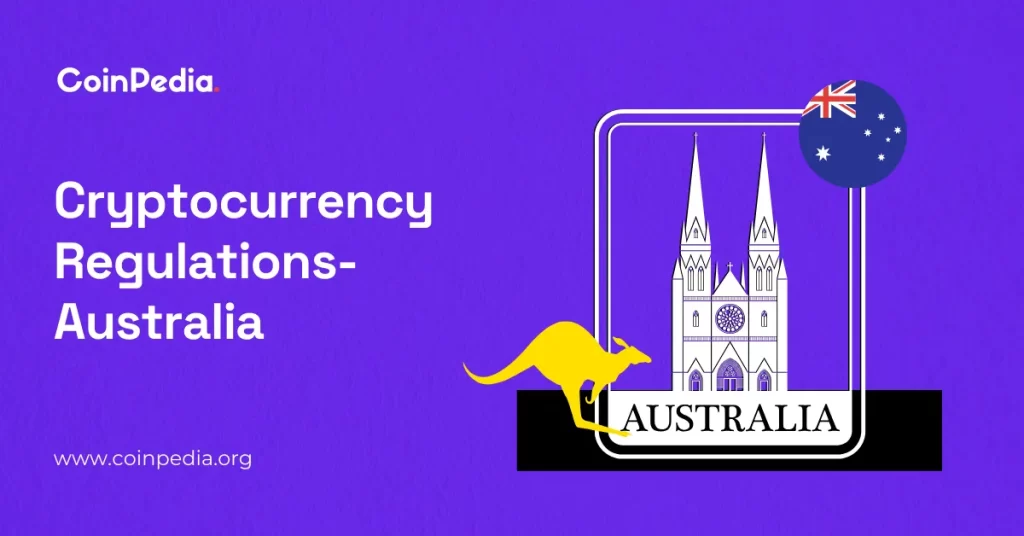Crypto Regulations in Australia 2025

The post Crypto Regulations in Australia 2025 appeared first on Coinpedia Fintech News
Australia is one of the most favorable regions to operate crypto-related activities. It has enacted a series of rules to mandate strict compliance with consumer protection and investors’ rights. It is a crypto-friendly country with a supportive stance towards innovation in blockchain technology and cryptocurrency. As of 2025, Australia is enhancing transparency to prohibit misleading or deceptive conduct in the crypto space.
Table of contents
- Crypto Regulations in Australia 2025
- What Is the Australian Government Saying About Crypto?
- Crypto License in Australia
- Crypto Tax in Australia
- Crypto Adoption in Australia
- Conclusion
- FAQs
Crypto Regulations in Australia 2025
September 18, 2025:
Australia’s Securities and Investment Commission (ASIC) announced a class exemption. This allows licensed intermediaries to distribute stablecoins without requiring separate regulatory approvals.
Firms overseen by Australian Financial Services will be able to offer fiat-pegged digital assets without holding a separate AFS, market, or clearing licence.
July 10, 2025:
The distributed ledger technology (DLT) platform, Hedera, joined the RBA’s (Reserve Bank of Australia) Project Acacia to explore the evolution of digital assets, including CBDC. It aims to analyze the development of the Australian wholesale tokenized assets market with digital money and the existing settlement infrastructure.
May 23, 2025:
The Australian government confirmed that 2025 is the year when previously discussed crypto regulatory reforms will become law. This marks a major regulatory shift, with new rules and licensing requirements coming into effect for the crypto sector.
May 15, 2025:
Treasurer Jim Chalmers announced that draft legislation for the new crypto regulatory framework will be circulated for public comment by the third quarter of 2025. Final rules are expected to follow after this consultation period.
April 2025:
New licensing requirements for Digital Asset Platforms (DAPs) were introduced and became effective. These changes are part of Australia’s move from passive oversight to proactive regulation, focusing on consumer safety and financial integrity.
March 21, 2025:
The Treasury outlined its crypto regulation plan, confirming that exchanges, custody services, and some brokerage firms will come under new laws. These entities must follow financial services rules, including obtaining an Australian Financial Services Licence and meeting minimum capital requirements. Payment stablecoins will also be regulated as stored-value facilities, with some exemptions.
Timeline of Major Crypto Regulations
| Date | Crypto Regulations/ Laws | Details |
| May 2, 2024 | AML/CFT Act | The Attorney General released the second consultation |
| 2023- 2024 | ASIC Enforcement/ Guidance | Enforcement against unlicensed activity, INFO 225 Guidance |
| March 29, 2023 | Introduction of Digital Assets Market Regulation | Proposed licenses for exchanges, custody, and stablecoins |
| February 3, 2023 | Token mappning consulation | Integrating crypto activities into existing laws |
| March 21, 2022 | CASSPrs Consultation | Proposed crypto service provider regulation |
| April 3, 2018 | DCE registration with AUSTRAC | Mandatory AML/CFT compliance for exchanges |
| March 2, 2010 | NCCP Act 2009 | Credit licensing for crypto lending |
| 2006 | AML/CFT Act | Mandatory obligation for DCEs |
What Is the Australian Government Saying About Crypto?
Currently, the Australian government is setting some upcoming regulations for cryptocurrency to enhance industry compliance and address debanking concerns. The government is planning to boost the country’s financial sector in the global economy and competitiveness with new crypto laws. Primary focus:
- Australian Securities and Investment Commission (ASIC) is focusing on consumer protection, market integrity, and enforcement.
- The Australian Transaction Reports and Analysis Centre (AUSTRAC) is ensuring compliance with anti-money laundering (AML) and counter-terrorism financing (CFT).
Crypto License in Australia
- The ASIC classifies crypto as a financial product, subjecting crypto exchanges and other platforms to an Australian Financial Services License (AFSL) and Market License Framework.
- In March 2025, Australia’s government announced plans for a new regulatory framework for cryptocurrency exchanges and platforms. The new rules introduced mandatory licensing, while small firms and software developers will be exempt from these obligations.
- ASIC is pushing for VASPs to hold market licenses, which have many restrictions.
Crypto Tax in Australia
- Is crypto taxable in Australia? Yes, ATO classifies cryptocurrency coins, stablecoins, NFTs, and tokens as property and assets of capital gains tax (CGT).
How is crypto taxed?
- If an individual is selling, trading, spending, or gifting crypto, the capital gain is included in the income tax. This income tax rate depends on the total income during the tax year.
- Important note: If cryptocurrency is held for longer than a year, a 50% capital gains tax discount can be availed.
- Reporting: The tax reporting deadline for the 2024-2025 financial year is October 31, 2025. The Australian Tax Office (ATO) can track crypto and impose severe penalties on tax evasion.
| Income of an individual | Tax rate |
| $0- $18,200 | 0% |
| $18,201 – $45,000 | 16% |
| $45,001 – $135,000 | 30% |
| $135,001 – $190,000 | 37% |
| $190,001+ | 45% |
Crypto Adoption in Australia
- In 2025, approximately 32% of Australians own cryptocurrency, positioning the country among the top global crypto adopters. It also marks a significant increase from 28% in 2024.
- 95% of Australians are aware of at least one cryptocurrency, with 75% of investors holding Bitcoin.
- The revenue in the crypto market in Australia & Oceania is projected to reach US$1.2 billion by 2025. The current crypto revenue in the region is growing at a rate of 19.29% and will reach US$1.4 billion by 2026.
- Crypto holdings: The Australian government’s crypto holdings are not publicly disclosed; it rather focuses on developing regulations and a framework for digital assets.
Conclusion
The Australian government is currently investigating the potential of central bank digital currency (CBDC) to integrate it into the country’s financial framework. While AUSTRAC and ASIC are developing consumer protection measures, the Aussie government is actively working to establish a successful regulatory balance between innovation and stability.
Never Miss a Beat in the Crypto World!
Stay ahead with breaking news, expert analysis, and real-time updates on the latest trends in Bitcoin, altcoins, DeFi, NFTs, and more.
FAQs
Crypto in Australia is taxed as capital gains or income, ranging from 0% to 45% based on your total income. A 50% capital gains discount applies if crypto is held for over a year.
The Australian Securities and Investment Commission (ASIC) focuses on consumer protection and market integrity, while the Australian Transaction Reports and Analysis Centre (AUSTRAC) handles anti-money laundering (AML) and counter-terrorism financing (CFT) compliance.
As of 2025, approximately 32% of Australians own cryptocurrency, a significant increase from previous years. 95% are aware of crypto, and 75% of investors hold Bitcoin.
Australia has a crypto-friendly stance, aiming to boost its financial sector with new laws that balance innovation and stability, focusing on consumer protection, market integrity, and anti-money laundering.
You May Also Like

Base chain introduces Flashblocks, reducing block time to 200 milliseconds

MetaMask Token: Exciting Launch Could Be Sooner Than Expected





